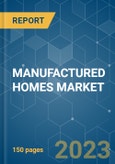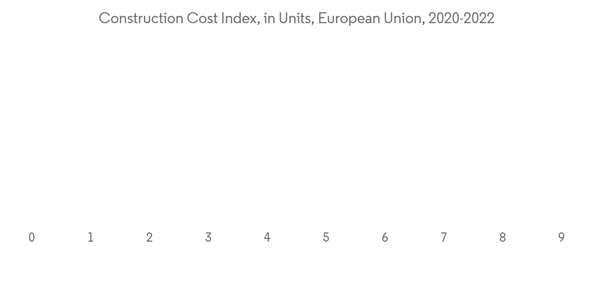The manufactured homes market is estimated to register a CAGR of greater than 5% during the forecast period. Supply chain issues related to the COVID-19 pandemic made it difficult to buy a home at affordable prices. Thus, more people have started turning to manufactured homes to achieve the dream of homeownership. As housing costs increase due to lumber price spikes and concrete shortages, many homeowners favor manufactured homes, leading to market growth.
Manufactured homes cost less because they are mass-produced and built on assembly lines, and manufactured homes are much more affordable than traditional homes. According to the Manufactured Housing Institute, manufactured housing costs about half of what a traditional house costs on a per-square-foot basis. The total cost of manufactured homes is around USD 100-200 per square foot; in contrast, a traditional new-build home averages USD 150 per square foot and can easily go as high as USD 400, depending on the locality. Furthermore, a modular home may be more expensive than a comparable manufactured one. Manufactured homes cost around USD 40 to 50 per square foot compared to USD 40 to 80 per square foot for modular homes. The average cost of a 2,000-square-foot modular home runs about USD 240,000. A comparable manufactured home runs more than USD 150,000-170,000. Customers can save hundreds of thousands of dollars by buying a manufactured home instead of a traditional one. Consequently, with the rising construction costs, the demand in the manufactured homes market may also rise.
According to the Manufactured Home Institute, companies that build manufactured homes generate up to 90% less waste than traditionally built homes. Transporting and assembling a manufactured home on-site causes significantly less environmental damage than building a traditional home. According to the Housing and Urban Development Code, manufactured homes in the United States must have high energy efficiency. Therefore, only some manufactured homes are Energy Star certified, meaning they have met the EPA's strict energy performance standards. Manufactured homes today are 27% more efficient than manufactured houses built in 2016, and that means significant energy savings.
Additionally, there is less wastage when building a manufactured home because of the effective development process, and the scraps are often reused. The materials used to build manufactured homes are selected for their energy efficiency along with a more environmentally friendly construction or design. A prime example is comprehensive insulation to reduce heat loss and heating fuel energy usage. By adding environmentally friendly/safe insulation to a manufactured home’s underside, walls, and roof alone, homes’ energy use decreases up to 31%. Due to less energy usage and reduced environmental damage, manufactured homes may see increased adoption in the coming years.
Key Highlights
- Construction costs for manufactured homes are typically lower, which may have contributed to their growing popularity in recent years. The rents in the manufactured home communities are also lower. According to a report, rent prices for a one-bedroom apartment are USD 1,600 per month. In contrast, mobile home park lot have an average rent of nearly USD 300 per month, and mobile home living becomes a uniquely affordable housing option for the general population.
- In a strong economy, housing price increases make it even harder for low-wage workers to afford a house. In a weak economy, job loss and wage reduction mean that more people need access to affordable housing. Thus, mobile home parks can do well regardless of economic turn. This ensures the growth of the market in all kinds of economic situations.
- Unlike single-family homes and apartment complexes, mobile homes can be manufactured in a fraction of the time of fixed construction, allowing them to keep pace with demand. While low home inventory is driven partly by overwhelming demand, it is also affected by a shortage of skilled workers and supply chain interruptions that keep building projects from being completed. Across the globe, the construction industry faces these issues. These can be circumvented through the faster, more efficient processes associated with mobile home manufacturing, thus making the market’s growth more certain.
- A recent study reveals 90% of people are satisfied with their mobile or manufactured home. 71% of residents cite affordability as the key driver for manufactured housing. About 62% of manufactured and mobile home residents anticipate living in their homes for another 10 years, and 38% don’t ever anticipate selling their homes. North America leads the global manufactured homes market, with the United States being the leading country in North America.
- There are an estimated 4.3 million manufactured home sites in the United States. Approximately 31% of new manufactured homes are placed in a community. Manufactured housing industry trends and statistics show 22 million people in the United States live in manufactured or mobile homes. Manufactured homes make up 9% of annual new home starts, and about 76% of new manufactured homes are titled as personal property.
Manufactured Homes Market Trends
Rising Construction Cost are Driving the Market Growth
Construction companies around the world have been facing increased cost pressures with rising steel and lumber prices. Materials, commodities, labor and supervision, subcontractors, and opportunistic cost, in general, are escalating in many places. There was a 10-16% price increase trend in the Americas over the 12 months of 2022. In Europe, increases of 10-25% (depending on the country) in 2022 have moderated but are still at elevated levels. The Asia-Pacific (APAC) experienced 10-12% inflation in 2022. Steel and other materials still need to meet demand, and a significant backlog is outstanding. With these cost increases, it becomes difficult for new homeowners to buy a home. Under such circumstances, people looking for a home may turn to manufactured homes.Manufactured homes cost less because they are mass-produced and built on assembly lines, and manufactured homes are much more affordable than traditional homes. According to the Manufactured Housing Institute, manufactured housing costs about half of what a traditional house costs on a per-square-foot basis. The total cost of manufactured homes is around USD 100-200 per square foot; in contrast, a traditional new-build home averages USD 150 per square foot and can easily go as high as USD 400, depending on the locality. Furthermore, a modular home may be more expensive than a comparable manufactured one. Manufactured homes cost around USD 40 to 50 per square foot compared to USD 40 to 80 per square foot for modular homes. The average cost of a 2,000-square-foot modular home runs about USD 240,000. A comparable manufactured home runs more than USD 150,000-170,000. Customers can save hundreds of thousands of dollars by buying a manufactured home instead of a traditional one. Consequently, with the rising construction costs, the demand in the manufactured homes market may also rise.
Energy and Environmenal Efficiency are Strong Growth Drivers
According to a new report, carbon emissions and energy consumption in the buildings and construction sector rebounded to pre-COVID-19 pandemic levels in 2021. Around 10 gigatonnes of carbon dioxide (CO2) were emitted into the atmosphere in 2021 by the construction sector, according to the 2022 Global Status Report for Buildings and Construction. This is equivalent to a 5% increase from 2020 levels, exceeding the last peak in 2019 by 2%. Additionally, 2021 also saw the most significant increase in energy demand in the buildings sector in the last ten years at 135 exajoules, as per the intergovernmental organization International Energy Agency data. A lull in emissions was recorded in 2020 when the construction sector had temporarily come to a halt, but the study reveals a rebound back to pre-pandemic levels. Energy is consumed in the form of electricity and gaseous, liquid, and solid fuels and district energy for building energy uses (e.g., heating, cooling, cooking, lighting, and equipment) and is responsible for around 27% of global operational-related CO2 emissions (10 Gt CO2). The production of materials used in the construction of buildings, including steel, aluminum, concrete, glass, and brick, when combined with CO2 emissions, account for around 37% of global energy and process-related emissions. With this increased energy consumption and emissions, there is a need to look for better alternatives.According to the Manufactured Home Institute, companies that build manufactured homes generate up to 90% less waste than traditionally built homes. Transporting and assembling a manufactured home on-site causes significantly less environmental damage than building a traditional home. According to the Housing and Urban Development Code, manufactured homes in the United States must have high energy efficiency. Therefore, only some manufactured homes are Energy Star certified, meaning they have met the EPA's strict energy performance standards. Manufactured homes today are 27% more efficient than manufactured houses built in 2016, and that means significant energy savings.
Additionally, there is less wastage when building a manufactured home because of the effective development process, and the scraps are often reused. The materials used to build manufactured homes are selected for their energy efficiency along with a more environmentally friendly construction or design. A prime example is comprehensive insulation to reduce heat loss and heating fuel energy usage. By adding environmentally friendly/safe insulation to a manufactured home’s underside, walls, and roof alone, homes’ energy use decreases up to 31%. Due to less energy usage and reduced environmental damage, manufactured homes may see increased adoption in the coming years.
Manufactured Homes Market Competitor Analysis
The manufactured homes market is fragmented in nature, considering the presence of several players, with the major players holding little market share. Cavco Industries, Clayton Homes, Skyline Champion Corporation, Karmod Prefabricated Technologies, and Adria are some of the major players in the market. The increasing popularity of manufactured home communities in North America and the increasing adoption of prefabricated construction across the globe make it easier for new players to enter the market. Still, these small players face fierce competition from established major players. Countries, where prefabricated construction has a certain stigma attached to it face high competition for the existing small demand in the respective market. The major players in the market mostly offer a wide range of products to have a competitive edge over other players. Start-ups try to break into the market with innovative products and technology integration.Additional Benefits:
- The market estimate (ME) sheet in Excel format
- 3 months of analyst support
Table of Contents
1 INTRODUCTION
4 MARKET INSIGHTS
5 MARKET DYNAMICS
6 MARKET SEGMENTATION
7 COMPETITIVE LANDSCAPE
Companies Mentioned (Partial List)
A selection of companies mentioned in this report includes, but is not limited to:
- Champion Home Builders
- Clayton Homes
- Skyline Champion Corporation
- Karmod Prefabricated Technologies
- Adria
- Epack Prefab
- Cavco industries
- General Coach Canada
- Samlans Homes Canada
- Ironwood Manufactured Homes
- Cumberland Japan
- Knight Mobile Homes
- Huasha Home
- K Home
Methodology

LOADING...










